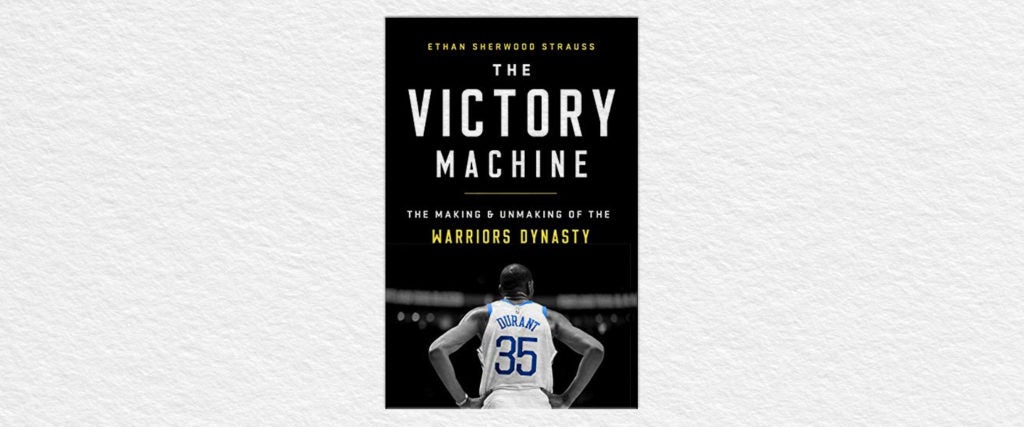There’s a type of book that gets written about every winning sports team that seeks to answer one question: How?
The characters are familiar to anyone who has read one — an owner who wants to win; a forward-thinking front office who embraces a tweak or inefficiency they can exploit to acquire undervalued talent; players who are driven by competitive mania and blessed by god with extraordinary gifts; and a coaching staff who either manages their egos or imposes their own genius onto the playbook. Even the problems — fights, bad contracts, media snafus — are rendered into ingredients you needed to brew up the eventual victory.
They have titles like Homegrown: How the Red Sox Built a Champion From the Ground Up; Astroball: The New Way to Win It All; Betaball: How Silicon Valley and Science Built One of the Greatest Basketball Teams in History; The Cubs Way: The Zen of Building the Best Team in Baseball and Breaking the Curse; and Belichick and Brady: Two Men, the Patriots and How They Revolutionized Football. Some of them are pure sportswriting artifacts, others take more of a business slant, but both operate from a shared moral vision: victory is good, and we ought to sit in observation of how it happens.
I don’t mean to sound too antagonistic. A lot of these books tell interesting stories about fascinating people. But their scope is limited by their form: sportswriting. Writing about sports as a day-to-day concern is a pro-victory racket. Winning squads do all the right things, a losing one is mired in top-to-bottom dysfunction that only a trade or a staffing overhaul can possibly fix. The subtleties of human experience get lost when you’re trying to answer binary questions.
And so, when I saw that writer Ethan Strauss, lately of the Athletic, was publishing a book called The Victory Machine: The Making and Unmaking of the Warriors Dynasty, I presumed it would be another volume in the tradition of books about victory. It’s right there in the title, after all. But it’s not. “Yeah,” says Strauss, “It’s really about the machine.”
Strauss’ efficient, dishy volume about the dynastic Warriors — who won the NBA title in 2015 and came back the next season to win 73 games, only to lose to LeBron James and the Cleveland Cavaliers in the Finals after building a 3-1 series lead, proceeded to sign Kevin Durant that very offseason, won the next two titles and then lost in 2019, when Durant tore his Achilles and left the team without a legitimate wing threat — is mostly unconcerned with victory as a means to an end. Instead, he probes into stranger, more fundamental questions: Does any of this make anyone involved happy? Is climbing the mountain and dominating the field on national television satisfying? Or does it just give the players heaving that trophy over their heads a novel way to be disappointed?
“My thoughts about the Warriors and what happened might have been formed early in college,” Strauss tells me. “My buddy, one summer, was trying to beat the Mario video game, and he worked tirelessly to do it in his pajamas, eating cereal, slovenly but focused. One day, he finally beats the game, and I remember that he suffered this crashing depression that he was quite articulate about. ‘This is all there is, and I’m just sitting around here, wearing my pajamas,’ he explained.”
In The Victory Machine, the role of Ethan’s Mario-dominating roommate is played by Durant. He’s one of the most gifted basketball players to ever live, the prototypical modern scorer, unguardable and efficient from every part of the court, and after a career spent in the mire of playoff disappointment playing with the Oklahoma City Thunder, he achieves ultimate basketball success with the Warriors. But, in Strauss’ observation, none of that ends up mattering all that much. He operates burner accounts on Twitter to defend himself against randos talking shit, worries about his broader status in the league, wondering aloud why his accomplishments haven’t put him in front of James in the public’s imagination and stresses out about the Warriors’ fan base regarding him as a carpetbagger and saving their real love for Steph Curry.
He also beefs with reporters on a whim, especially Strauss. In 2019, he even aired him out in a press conference, after he reported on the ongoing buzz about Durant’s upcoming free agency, which seemed to be indicating a move to the New York Knicks. (He ended up opting for a job with the nearby Nets, instead.)
The ensuing hullabaloo around Durant’s presser ends up giving Strauss insight into what life is like as a public figure who can find hundreds of opinions about themself on the internet at any given time. “For a famous person, it’s scaled up to a level that’s psychologically impossible to deal with,” Strauss explains. It’s irritating, but also buzzy and stimulating, a fire you walk into like a mosquito, flinching away when it burns you with its overwhelming contempt, but always managing to pull you back in with its overwhelming glow.
In one memorable passage, Strauss recounts running into Durant at a hookah bar right before his first season playing in Oakland. Some sailors walk in — it was Fleet Week — and Durant peppers them with questions about their lives, takes a selfie with them and sends it to DeAndre Jordan and is just generally amiable with these complete strangers who live on a boat. One of the officers asks Durant what being in the NBA is like, and he replies, “It’s cool. I worked really, really hard for this. You know, soon I’ll be 30, and guys like Ethan will start saying, ‘I’m old,’ and it will end.”
Durant might be wildly successful, but he can feel the bottom coming up, a fact that clearly drives him crazy. And why shouldn’t it? Most jobs set you on a path of ongoing progression — or at least, lie to you about it, convincing you that you will get better at your craft and stack up more and more successes until you become a wizened elder and retire with a cadre of friends and admirers. But in Durant’s profession, one that he killed himself to get to the top of, you inevitably start to burn out when you hit your mid-30s. It’s an excruciating axe over a player’s head.
“I think he might be unusually focused on that kind of thing,” Strauss tells me. “But they’re all typically aware that this ends, and they’ve been told countless times by peers and by older players that this will end. It just seemed like, that night, he was very wistful. He was just completely obsessed with these Naval officers, and he wanted to know about everything that they do. I do think he’s got a sense of his basketball mortality, and he’s trying to figure it all out. I think that life has been pretty difficult for Kevin, and he really does love basketball. So I think he has those thoughts of, ‘What’s going to happen when this isn’t there?’”
As Strauss outlines, the modern NBA player fundamentally exists in a world that pulls them in a lot of different directions — despite the common narrative that winning teams are bands of brothers, united in common cause and able to put aside their differences to scale the mountain to victory. They’re juggling all kinds of needs, emanating out of all kinds of competing parties (family, long-time friends, representatives and sponsors, among others). But the best players (a la Durant) are beholden to a force that functionally acts as their second employer — sneaker companies. “They’re the invisible foot of the league,” Strauss tells me. “They have a lot of influence at the top. They weigh heavily on the top players’ psyches. They play more to their individuality; they’re literally marketing them, as opposed to the team’s accomplishments.”
“A few years ago,” Strauss continues, “John Wall didn’t love that when he walked around everywhere, he saw kids wearing Kyrie Irving’s shoes. For a guy like John Wall, it was a representation that he was a tier below Kyrie, and he was reminded of it every time he walked outside. For the guys at the very top, it seems like it’s huge. There was a lot of friction between Shaq and Penny Hardaway over their different sneaker lines, with Shaq even smacking the Lil’ Penny character.” (In fairness, it’s more like a nudge.)
As such, Durant signing with the Warriors, the best team in the NBA coming off a freak loss in the Finals, wasn’t just a coup for the Warriors. It was also massive for Nike, Durant’s sportswear sponsor, who didn’t have a major presence on the Warriors after they botched their recruitment of Curry, who opted to sign with Under Armour instead.
“Sneakers are the thing that have the potential to extend one’s career after the career is done,” says Strauss. “Kobe Bryant had shoes after he retired. Michael Jordan makes more money, every year, off his shoes, than he made with his entire NBA earnings, combined. This is the bigger game. This is the end that the other stuff is a means to, and they’re very competitive about it.”
Here, though, Durant seems once again blocked by James. “There’s a huge gap between how Nike markets LeBron James and how they market Kevin Durant,” Strauss tells me. Case in point: When Durant netted the Finals MVP trophy in 2017, he expected it he would cement his reputation among Nike executives and the shoe buying public as the number one dude. But alas, people in the Bay just liked Curry more, and the public at large wasn’t done with LeBron as daddy. “They can be 1 and 1A as far as how good they are, but they’re not 1 and 1A in terms of how they’re marketed,” Strauss continues. “There’s a massive difference there. That’s something that can understandably stick in the craw of a player. It’s just not something that sportswriters tend to focus on.”
Strauss cites David Halberstam’s The Breaks of the Game and Playing for Keeps: Michael Jordan and the World He Made as influences on The Victory Machine, particularly noting the similarities between his book and Playing for Keeps in terms of keeping the bigger picture in mind. Not that it was Halberstam’s original intention. In fact, when Halberstam set out to write about Jordan’s last season with the Bulls, he figured he was going to be able to get an interview with the man, find out what made him tick and all that shit. But Jordan ended up declining, choosing instead to float above the clouds and seem immortal, at least for a few more years. Book contract in hand, yet subject in the wind, Halberstam shifted his focus and wrote about how the NBA was pushed straight into the creation of the 1990s media omniplex when Jordan’s spectacular, world-breaking play made him monumentally famous and brought the whole league along for the ride.
Halberstam doesn’t harvest too many psychological insights about Jordan but there’s one that’s always stuck with me: He was an incredible compartmentalizer, able to shift into whatever mode necessary for the situation at hand (on or off the court). This skill made him a perfect creature of his profession — an athlete and pitchman alike. In turn, he transformed the NBA into a farm system for brands looking for the next megathete to make into the next ultrabrand — their own personal Air Jordan that could print money on their behalf for decades to come.
But as Durant’s eternal psychic pain seems to make clear, this money definitely can’t buy happiness.

